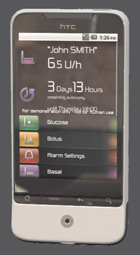The Debiotech JewelPump is a disposable patch pump with some similarities to the current Omnipod, as well as other patch pumps on the horizon. Debiotech, a Swiss company, teamed with ST Microelectronics to create this sleek pump system. Like most patch pumps, a separate controller is required to deliver bolus insulin doses. It uses a microelectromechanical (MEMS) pumping system, that allows the pump to be kept small and light.
The Pump

ST Microelectronics created the pump as a miniaturized silicon mechanism that can be mass-produced. A MEMS approach was adopted to focus on the aspects of miniaturization, safety, reliability, and accuracy. The entire pump pod is flat, making it easy to wear the pump under clothing without producing a bulge. The large case required to hold it’s 450 unit bladder reservoir, unfortunately, makes it wider than most other patch pumps.
Since it’s a patch pump, there are no tubes or extra infusion sites. A cannula and cradle are attached directly to the body. The insulin pod and separate pumping unit snap right into place on top of it. This allows you to easily detach the pod when necessary (i.e. changing infusion sites, replacing the reservoir, soaking in a hot tub, etc). The JewelPump site has some great videos showing exactly how the pump works that are worth taking a look at after you read about it here.
The insulin reservoir and base unit or cradle are disposable. After 6 days of use, you pop the pod out of the cradle, pull out the reservoir, throw it away and insert a new reservoir. The reservoir bladder can hold between 85 and 450 units of insulin. At this time, the FDA has not approved any insulin pump for more than 3 days of use, although Novolog has been shown to be stable in pumps for at least 6 days.
A disposable unit helps cut the large upfront cost of line pumps. Instead of a purchase price of $6,500 or so when you first start using the device, the starting cost could be closer to $1500. Your insurer then makes monthly or quarterly payments to get replacement reservoirs. Like the Omnipod, the price for supplies over time are likely to exceed the purchase cost and maintenance of a line pump.
The Controller

The pump is controlled by a separate device with a large color touchscreen that communicates via Bluetooth. The controller was originally designed to be an App that runs on Android phones, meaning any phone with the app could control the pump via a secure connection. Their website shows the control device as an HTC phone, but they refer to it as a PDA.
The FDA is hesitant to allow cell phones to manage the delivery of medication due to concerns about secure communication with the pod and the rapid software changes that occur in cell phone technology. If a new cell phone is purchased, you would need to set it up to work with your device only. Bluetooth pairing works fairly well but there have been some issues in the past (i.e. profile mismatches, being unable to find a device, etc.). So far, the FDA has not allowed a third party system to be the main controller for an important device like an insulin pump. Debiotech will likely develop its own independent controller, similar to Omnipod and the anticipated Cellnovo system, for use in the US.
In today’s current smartphone market, there are a number of Android phones available that operate on differing versions of the software. This wide range of choices is nice for the person who already has an Android phone or who is tied in with a specific company in a contract. Unfortunately, the phone makers choose which version of the operating system is installed, the updating cycle, which apps are preinstalled (also known as bloatware), as well as the design of the handset.
It takes a lot of work to ensure that a pump app works with both new and old cellphone software versions and with all the different handsets as well as ensuring consistent visibility and ease of use. Creating a safe insulin dosing app that will run on multiple systems may be impossible. Keeping up with changing cell phone technology over the 4 or 5-year lifespan of an insulin delivery app would require a small army of sophisticated software engineers.
According to Amy Tendrich in her Diabetes Mine Blog, the JewelPump app pretty much takes over the phone when it’s in use. When you start up the app, all other functions are disabled, including sending and receiving phone calls and other alerts. This is a step in the right direction and it shows that they are thinking about the initial pitfalls of having this separate third party device.
Features
All the features we’ve come to expect from pumps are in there, including bolus on board (no word on exactly how it’s handled), occlusion detection, built-in vibrator alarm, and more. The pod will also come in different colors.
So where is it?
Unfortunately, the news portion of the JewelPump website hasn’t had an update since June of 2010. They were also absent from this year’s (2011) ADA meeting. Although the company appears quiescent, the features and possibilities of a device like this one are worth talking about.
Last Updated on November 13, 2019

